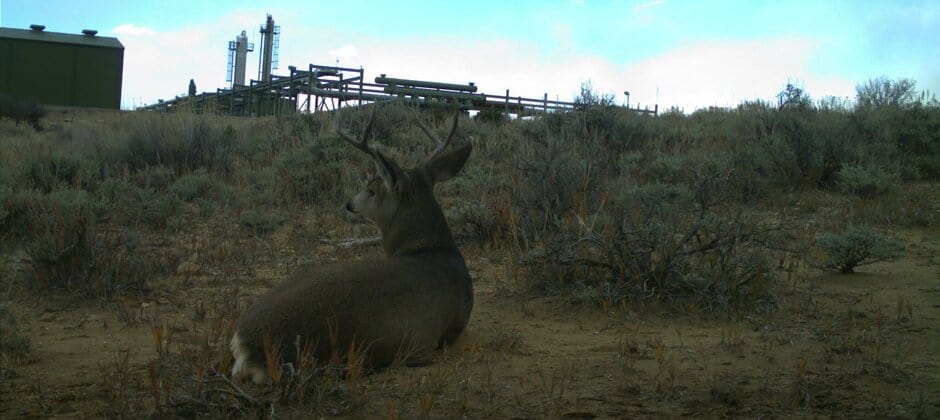Share this article
Deer and rabbits avoid fracking development
Mule deer around fracking areas may be leerier of the noise from the operations than the actual structures. Rabbits, on the other hand, don’t seem to be affected by the sounds at all.
New research tracking wildlife using a combination of trail camera and sound recordings has revealed in finer detail how deer and rabbits respond to different types of human activity and development.
“Ecology is complicated — animals are cuing into many different things on the landscape,” said Patrick Lendrum, who was finishing his PhD at Colorado State University at the time he conducted this research, published recently in the Journal of Animal Ecology.
Lendrum initially started his research using only camera traps in the winter of 2014, tracking mule deer (Odocoileus hemionus) in areas of northwestern Colorado that were being developed for gas resources through hydraulic fracturing, or fracking.
Past research had shown that the deer typically avoided roads and well pads, or areas cleared for drilling. Deer also altered timing of their activity based on the level of development in some areas and migrated more quickly through developed areas. But researchers still weren’t sure if the people, the structures, or perhaps even the noise bothered the deer.
In 2015, Lendrum and his colleagues paired 32 of the cameras they deployed on the landscape along with acoustic recorders to see if deer responded differently to noisy development than relatively quiet operations.
The researchers found that mule deer did, in fact, respond to the noise. They tended to avoid busier, noisier roads more than quiet roads leading to the wells and related structures. And while their cameras detected deer in nearly all of the areas they studied, they were found more commonly away from roads.
Lendrum said mule deer also tended to select areas that had more pinyon juniper cover, according to other research conducted in the area and published recently in Wildlife Monographs. “It highlights the importance of having good habitat cover on the landscape,” he said.
Surprisingly, when this study took place, deer were more likely to be observed closer to well pads, which is not what has been previously observed. It’s possible that deer were becoming more used to the well pads, though Lendrum noted it was hard to tell the reason. Nevertheless, deer densities were higher in undeveloped areas than in developed areas, he said, according to the Wildlife Monographs study.
Hares and rabbits also avoided areas around natural gas facilities, they found. In contrast to deer, rabbits and hares in the study areas were found more commonly around roads.
Lendrum isn’t sure why this is, but speculates that it could have something to do with microhabitat preferences. Perhaps vegetation is more suitable for rabbits near roads, for example. It also might be that the roads provide sort-of protection for rabbits and hares, scaring away predators.
Lendrum also noted that the study took place after the wells had been built. Initial construction is typically the loudest time, which also sees the most human activity. However active pumping is quieter, with humans only coming in to do maintenance or equipment checks.
But he wonders if there is an acoustic threshold of sound that the deer are willing to tolerate around wells. He said it would be interesting if future researchers looked more into this. The impact of the gas fields didn’t seem to have a larger effect on the population of the larger region, though.
“It’s interesting to see how these animals can adapt and still do well around disturbances,” he said.
Header Image: Deer respond to noise in fracking areas. Credit: Patrick Lendrum








